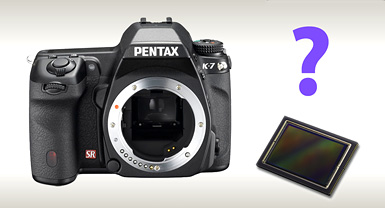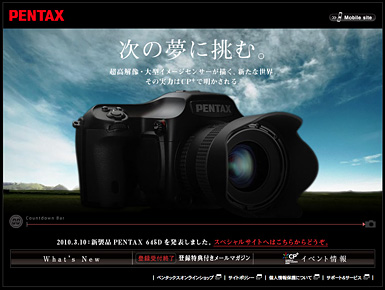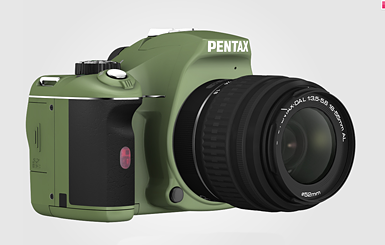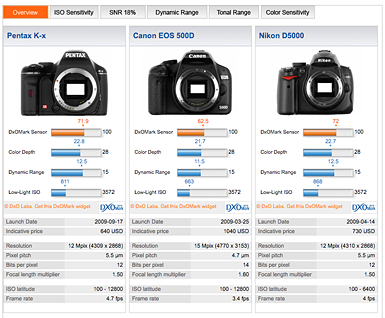“Full Frame” Unfulfilled
August 10, 2010
If you put any faith in DxO Mark scores (and I do understand their limitations), today’s best $500 DSLRs make better images than all of the sub-$4000 cameras sold until 2008. Largely that’s thanks to some good recent APS-C sensors from Sony.
So I’m not sympathetic towards certain Pentax users, who bleat that they can’t make adequate photographs—not until the company delivers a DSLR with a 24×36 mm sensor. (With pre-Photokina Pentax rumors swirling, the issue is once again a hot topic for discussion.)

Full-Frame Pentax?
Yes, many long-time Pentaxians do have investments in full-frame “FA” lenses, ones that could cover the format.
But keep in mind, over the history of photography there have many camera mounts which died out entirely—obsoleting numerous fine lenses. How about Contax/Yashica mount? Minolta MD, or Canon FD? (Or even earlier systems, such as Exakta or the superb Zeiss Contarex?)
By contrast, any Pentax lens made since 1983 can at least be used on a modern DSLR—metering automatically, and with the benefit of built-in shake reduction. So the handwringing that some great lenses have been “orphaned” by Pentax can get a bit exaggerated.
Some point out hopefully that not long ago, Pentax introduced new telephoto lenses bearing the FA designation. Ergo, full-frame is coming!
But truthfully, no decent lens design even breaks a sweat in covering an image circle much smaller than its focal length. With a telephoto, full-frame coverage is basically “free”—so why not go ahead and use the FA labeling? It allowed Pentax to finesse the format question for a while longer; and maybe even sold a couple of extra lenses to Pentax film-body users.
I do agree with the complaint that the viewfinders of most consumer DSLRs are puny and unsatisfying. The view through the eyepiece of a full-frame body is noticeably more generous.
However, the electronic viewfinder of an Olympus E-P2 neatly solves this problem too—at a price savings of about $1400 over today’s cheapest full-frame DSLR. And the EVIL wave is only gathering momentum.
The perpetual cry from full-frame enthusiasts is that Moore’s Law will eventually slash 24x36mm sensor pricing. To me, this seems like a wishful misunderstanding of the facts.
The shrinking of circuit sizes which permits faster processors and denser memory chips is irrelevant to sensor design—the overall chip dimensions are fixed, and the circuitry features are already as small as they need to be.
Also, figuring the costs of CMOS chip production is not entirely straightforward. It costs money to research and develop significant new improvements over prior sensor generations; it’s expensive to create the photolithography masks for all the circuit layers. Then, remember that all these overhead costs must be recouped over only two, perhaps three years of sales. After that, your sensor will be eclipsed by later and even whizzier designs.
Thus, there is more to a sensor price than just the production-line cost; it also depends on the chip quantities sold. And full-frame DSLRs have never been huge sellers.
If APS-C sensors prove entirely satisfactory for 95% of typical photographs (counting both enthusiasts and professionals), a vicious circle results. With no mass-market camera using a full-frame sensor, volumes stay low, prices high. But with sensor prices high, it’s hard to create an appealing camera at a mass-market price point.
Furthermore, let’s consider the few users who would actually benefit from greater sensor area.
For the few who find 12 megapixels inadequate, nudging the number up to 24 Mp is not the dramatic difference you might imagine. To double your linear resolution, you must quadruple the number of pixels. Resolution-hounds would do better to look to medium format cameras, with sensors 40 Mp and up—which conveniently, seem to be dropping towards the $10,000 mark with the release of Pentax’s 645D.
The last full-frame holdouts are those who need extreme high-ISO potential. There’s no doubt that the 12Mp full-frame Nikon D3s makes an astounding showing here, with high-ISO performance that’s a solid 2 f/stops better than any APS-C camera. This is a legitimate advantage of class-leading 24×36 mm sensors.
Yet aside from bragging rights, we have to ask how many great photographs truly require ISO 6,400 and above. ISO 1600 already lets us shoot f/1.7 at 1/30th of a second under some pretty gloomy lighting—like the illumination a computer screen casts in a darkened room.
A day may come when sensor technology has fully matured, and every possible sensitivity tweak has been found. At that point, a particular sensor generation might hang around for a decade or more. So might those long production runs permit much lower unit costs for a full-frame sensor? There will still be a full-frame surcharge simply from the greater surface area and lower chip yields.
But who knows, perhaps it’s possible? By then we may have 40 Mp, 24×36 mm chips that are our new new “medium format.”
Pentax: Sensors or Lenses?
May 30, 2010
On Pentaxian discussion boards, one dispute that absolutely refuses to die is whether Pentax will (or should) introduce a “full frame,” 24x36mm sensor DSLR.
The pleading for 24×36 often comes from those who might have already invested heavily in earlier FA lenses—meaning, ones originally designed to cover the old 135 film format.
I understand the emotion here—it’s quite true that an APS-C sensor wastes some of the capabilities of those lenses. And let’s take it as given that Pentax’s engineers would be fully capable of producing an excellent 24×36 camera.
But does Pentax “owe” its existing customers such a model?
Whither Pentax?
May 7, 2010
I guess this was the week for Pentax’s European executives to go rogue.
Hiroshi Onoda made some comments to the Spanish Pentaxeros website, hinting at future “more professional” DSLRs (google translation). Then, Stephen Sanderson told the UK’s Amateur Photographer that Pentax “hadn’t ruled out” a mirrorless, EVIL model.
Both statements were vague and ambiguous enough to set off a storm of speculation on Pentaxian discussion boards. Many hearts fluttered, imagining Pentax might introduce a DSLR based on a 24 x 36mm “full frame” sensor; others wondered whether they might join Olympus and Panasonic in the Micro Four Thirds camp.

Pentax Surprises Ahead?
But there’s two key facts that must always be remembered about Pentax:
- They do not make their own sensor chips
- Last year, the company almost went under
At PMA 2010, Pentax USA president Ned Bunnell gave an interview with Imaging Resource. He said plainly that Hoya, Pentax’s new corporate owners, were demanding more focus on the bottom line, and a clearer marketing strategy.
So, Pentax simply cannot build every camera its fanbase thinks might be cool.
Today is Pentax Day
March 11, 2010
There’s two interesting blips of Pentax news this week.
The first is that after several years of dithering, Pentax finally introduced its professional, medium-format digital camera, the 645D. DP Review has more details.
Note that the designation “645” was approximate even in the film era (the actual image area then was 56 x 41.5 mm). The 44 x 33 mm size of the new sensor makes the name completely arbitrary.
Now, ordinarily this blog wouldn’t have much to say about a 40-megapixel camera costing ~$10,000 (not to mention one that is so large and awkward-looking). But there’s two points to make:
First, this is priced at half of what its direct competitors from Mamiya and Hasselblad cost. It’s cheaper than a lot of motorcycles. That gets into range even for obsessive hobbyists or wealthy dabblers.
Second, it uses a Kodak-built 40-megapixel sensor (it’s assumed to be the KAF-40000). Its 6-micron pixels are promised to offer high dynamic range and low noise. And coincidentally, those specs match a “rule of thumb” that I suggested two months ago.
Meanwhile, from this blog’s viewpoint, the week brought a much more significant bit of Pentax news: DxO Mark announced its test results for the K-x.
Keep in mind that DxO Labs only measures pure sensor performance in raw capture; they don’t evaluate a camera’s features, handling, or JPEG quality.
Still, it’s clear that the image quality of the K-x is a big leap forward for Pentax.
This is widely assumed to reflect a switch from Samsung to Sony as the sensor supplier for the K-x. As I mentioned Tuesday, Sony’s current 12 Mp APS-C sensor seems to be at the heart of some highly-respected models from Nikon, Ricoh, and (probably) Leica.
DxO Labs did find that (in common with other Pentax models), ISO 3200 and above have some noise reduction baked in, even with the nominally “raw” file.
This is undesirable in theory—doing the noise reduction later on a desktop computer offers more flexibility and processor horsepower. But for casual JPEG shooters, it’s probably welcome.
In any case, it seems the K-X has better image quality than Canon and Nikon’s current entry-level DSLRs. (DxO Labs, based in France, uses the European designation EOS 1000D, known as the Rebel XS in North America).
And the K-x also holds its own against the more-expensive Canon 500D and Nikon D5000. (The 500D is also called the Rebel T1i. Canon, how do you cook up these weird North American model numbers?)
In case anyone was worrying, reviews say that the K-x does a good job of turning the raw data into a nice-looking JPEG, too.
The K-x is about a $500 camera (prices have been fluctuating lately), and it’s not large.
So the K-x really becomes the “sanity check” for any other camera coming onto the market today—whether “hybrid” or EVIL, or whatever other jargon you prefer.
Panasonic G1/G2/G10? Barely any smaller! Ricoh GXR+A12 Module? Twice as expensive—for the same darned sensor!
Today, the Pentax K-x has become the conscience of the camera market.
Pentax Puzzler: Colored Cameras
February 1, 2010
And now for something completely trivial.
Pentax’s recent “upper entry-level” DSLR, the K-x, has been getting favorable reviews lately. Within its circa-$550 price bracket, it offers a lot of value; in particular, “its high ISO JPEGs are possibly the best of all current DSLRs with an APS-C size sensor” (making it an intriguing model for me).
But marketing being what it is, the K-x is equally well known as the DSLR you can get in different colors. Woowoo!
In fact, within Japan, you can use an online configurator to choose between dozens of different finish options.
Yes, some of the colors, like pink, attain frightening Hello Kitty levels of awfulness. But once you open your mind to the possibility of colored cameras, some of the choices are rather handsome.
Which makes Pentax’s meager color choices for those who live elsewhere rather disappointing.
There’s basic black, of course. But the “colorful” versions in my part of the world are limited to red, white, and blue. (Is this on purpose?)
I won’t be too hard on the white version:
To my tastes, this look is a bit too “dental office.” But there’s a practical argument in favor of it.
A light-colored body won’t heat up as much in sunlight. This is probably healthier for the electronics; and it may even reduce image noise, in a few situations.
Buyers of the white K-x enjoy calling it the “Imperial Stormtrooper” edition.
The navy blue variant seems to be aiming for a metallic auto-body style:
Okay, that’s a very sober, masculine, and tasteful color. Great if you’re a silver-haired attorney, buying a luxury sedan.
But it’s not very, you know… colorful. And painting plastics in metallic finishes just makes them look more plasticky, not less, if you ask me.
As an alternative, what about this?
Now, that ought to be a hit among the outdoors crowd. It works for both tree-hugging birdwatchers and camo-wearing deer hunters. Olive isn’t bad either.
Tan has the same advantage of being a lighter color, but without showing dirt quite as quickly as white. And it gives the nice bonus of reducing the visual “weight” of the camera—making it less intimidating for people photos.
The most questionable K-x color option is the screaming fire-engine red:
Ouch. Okay, that is colorful. But it’s rather garish and conspicuous. And red+black feels very dated to me. Is this some ironic 1980s reference I’m not getting?
Anyway, let’s assume red was supposed to be the “fun & playful” option. How about acid green instead:
Again, it lightens the camera (literally and figuratively), while adding a bit of cheerfulness.
In the end it’s all a matter of taste of course.
But still—if Pentax is already producing so many different colors, who picked out such unimaginative ones?







